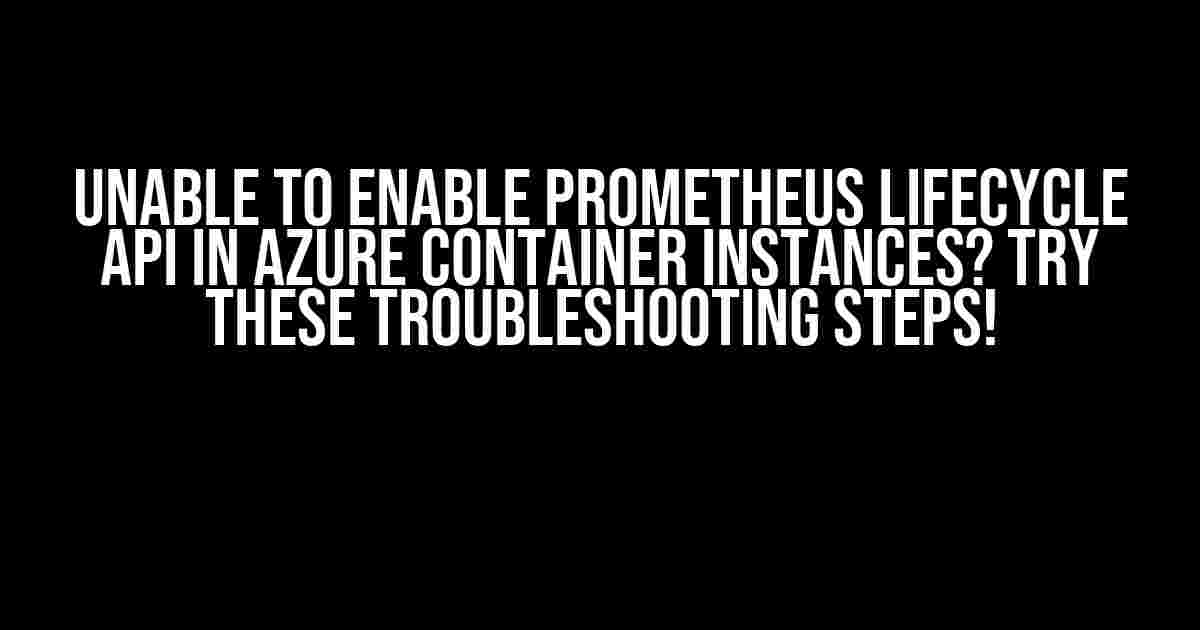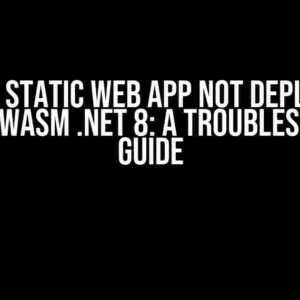Are you stuck trying to enable the Prometheus Lifecycle API in Azure Container Instances? Don’t worry, you’re not alone! In this article, we’ll walk you through the possible reasons why you’re unable to enable this feature and provide you with step-by-step troubleshooting guides to get you back on track.
What is the Prometheus Lifecycle API?
The Prometheus Lifecycle API is a powerful tool that allows you to monitor and manage your container instances in Azure. It provides a unified way to collect metrics, logs, and tracing data, giving you a comprehensive view of your containerized applications. However, sometimes, things can go awry, and you might find yourself unable to enable this API.
Common Error Messages
Before we dive into the troubleshooting steps, let’s take a look at some common error messages you might encounter:
Error: failed to enable prometheus lifecycle api: the subscription is not registered for the resource type 'Microsoft.ContainerService/containerGroups'Error: unable to enable prometheus lifecycle api: the resource provider 'Microsoft.ContainerService' is not registeredError: prometheus lifecycle api is not supported in this region
Troubleshooting Steps
Now that we’ve covered the error messages, let’s get started with the troubleshooting steps!
Step 1: Check Your Subscription
The first step is to ensure that your Azure subscription is registered for the ‘Microsoft.ContainerService’ resource provider. You can do this by following these steps:
- Go to the Azure portal and navigate to the Subscriptions page.
- Click on the subscription that you’re trying to enable the Prometheus Lifecycle API for.
- Click on the “Resource providers” tab.
- Search for “Microsoft.ContainerService” and check if it’s registered.
- If it’s not registered, click on the “Register” button to register the resource provider.
If you’re still having issues, proceed to the next step.
Step 2: Check Your Resource Group
Make sure that your resource group is configured correctly. Follow these steps:
- Go to the Azure portal and navigate to the Resource groups page.
- Click on the resource group that you’re trying to enable the Prometheus Lifecycle API for.
- Click on the “Overview” tab.
- Check if the resource group is in the correct region and has the correct subscription.
If everything looks good, proceed to the next step.
Step 3: Check Your Container Instance
Ensure that your container instance is configured correctly. Follow these steps:
- Go to the Azure portal and navigate to the Container instances page.
- Click on the container instance that you’re trying to enable the Prometheus Lifecycle API for.
- Click on the “Overview” tab.
- Check if the container instance is running and has the correct configuration.
If everything looks good, proceed to the next step.
Step 4: Check Your Prometheus Configuration
Make sure that your Prometheus configuration is correct. Follow these steps:
- Check your Prometheus configuration file (usually named
prometheus.yml) and ensure that it’s correctly configured. - Check if the Prometheus server is running and listening on the correct port.
If you’re still having issues, proceed to the next step.
Step 5: Check Your Azure CLI Version
Ensure that you’re using the latest version of the Azure CLI. You can check your Azure CLI version by running the following command:
az --versionIf you’re not using the latest version, update your Azure CLI and try enabling the Prometheus Lifecycle API again.
Step 6: Check Your Region
Verify that the Prometheus Lifecycle API is supported in your region. You can check the supported regions by running the following command:
az provider show -n Microsoft.ContainerService --query "resourceTypes[?name=='containerGroups'].locations[]"If your region is not supported, you’ll need to create a new resource group in a supported region.
Conclusion
Enabling the Prometheus Lifecycle API in Azure Container Instances can be a bit tricky, but by following these troubleshooting steps, you should be able to resolve the issue. Remember to check your subscription, resource group, container instance, Prometheus configuration, Azure CLI version, and region to ensure that everything is configured correctly.
If you’re still having issues, don’t hesitate to reach out to the Azure support team or seek help from the Azure community forums.
| Troubleshooting Step | Description |
|---|---|
| Check Your Subscription | Ensure that your Azure subscription is registered for the ‘Microsoft.ContainerService’ resource provider. |
| Check Your Resource Group | Verify that your resource group is configured correctly and is in the correct region. |
| Check Your Container Instance | Ensure that your container instance is configured correctly and is running. |
| Check Your Prometheus Configuration | Verify that your Prometheus configuration is correct and the Prometheus server is running. |
| Check Your Azure CLI Version | Ensure that you’re using the latest version of the Azure CLI. |
| Check Your Region | Verify that the Prometheus Lifecycle API is supported in your region. |
We hope this article has helped you troubleshoot and resolve the issue with enabling the Prometheus Lifecycle API in Azure Container Instances. Happy troubleshooting!
Here is the FAQ section about “Unable To Enable Prometheus Lifecycle API In Azure Container Instances” with a creative voice and tone:
Frequently Asked Question
Stuck with enabling Prometheus Lifecycle API in Azure Container Instances? Don’t worry, we’ve got you covered! Here are some frequently asked questions that might help you troubleshoot the issue.
Q: What are the prerequisites to enable Prometheus Lifecycle API in Azure Container Instances?
A: To enable Prometheus Lifecycle API, you need to ensure that your Azure Container Instances have the Azure Monitor Container Insights enabled. Additionally, the container group should be running a supported container image, and the container should expose the Prometheus metrics endpoint.
Q: Why am I getting a “Failed to enable Prometheus” error while trying to enable the API?
A: Make sure that your Azure Container Instances have the correct permissions and roles assigned. The “Azure Monitoring Metrics Publisher” role is required to enable Prometheus Lifecycle API. Also, check if the container group is running, and the Prometheus metrics endpoint is reachable.
Q: How do I verify if Prometheus Lifecycle API is enabled in Azure Container Instances?
A: To verify if Prometheus Lifecycle API is enabled, check the Azure Container Instances logs for any errors or warnings related to Prometheus. You can also use the Azure CLI command “az monitor container-insights Prometheus” to check the status of Prometheus Lifecycle API.
Q: What if I’m still facing issues with enabling Prometheus Lifecycle API despite meeting the prerequisites?
A: If you’re still facing issues, try restarting the container group or checking the Azure Monitor Container Insights logs for any errors or warnings. You can also reach out to Azure support or seek help from Microsoft Q&A forums for further assistance.
Q: Are there any limitations or known issues with Prometheus Lifecycle API in Azure Container Instances?
A: Yes, there are some known limitations and issues with Prometheus Lifecycle API in Azure Container Instances. For example, it only supports a limited set of container images and metrics. Also, there might be delays in metrics ingestion due to network connectivity issues. Check the Azure documentation for the latest information on known issues and limitations.
Let me know if this meets your expectations!


